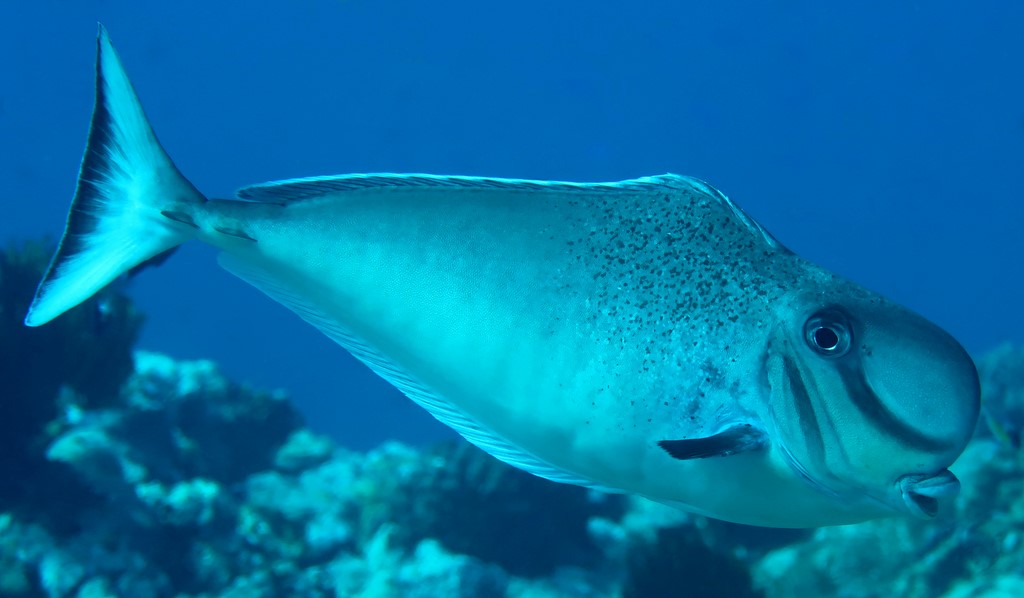NASO TONGANUS - (VALENCIENNES, 1835)
Picture courtesy of: Alain Daoulas
Actinopterygii (Gigaclass) > Actinopteri (Class) > Teleostei (Subclass) > Acanthuriformes (Order) > Acanthuridae (Family) > Naso (Genus)
Nason loupe, Bulbnose unicornfish, Hump-nosed unicornfish, Humphead unicornfish, Humpnose unicorn, Humpnose unicornfish, Hompmeus-eenhoringvis, Wulst-Nasendoktor, Tosaka-hagi, Tosakahagi, トサカハギ, 球吻鼻魚,
Synonyme
Naseus tonganus (Valenciennes, 1835)
-------------------------
Description
Dorsal spines (total): 5; Dorsal soft rays (total): 27-30 (usually: 28); Anal spines: 2; Anal soft rays: 26-28 (usually: 26); Pectoral fin rays: 16; Pelvic fin rays: I, 3; Gill rakers on anterior of first arch: 8+9=17; Upper jaw teeth: 43; Maximum body depth: 2.2 (subadult)-3.0 in SL; Head length: 24.5 in SL; Snout length: 12.7 in SL; Orbit diameter: 5.1 in SL; Preorbital depth: 15.7 in SL; Interorbital width: 8.2 in SL; Length of dorsal fin base: 64.0 in SL; First dorsal spine length: 5.9 in SL; Fifth dorsal spine length: 7.9 in SL; Pectoral fin length: 13.8 in SL; Pelvic spine length: 9.8 in SL; Prepelvic length: 25.5 in SL; Predorsal length: 32.6 in SL; Preanal length: 30.5 in SL; Length of 1st caudal spine base: 5.5 in SL; Length of 2nd caudal spine base: 3.9 in SL. Body shallow; Snout with a bulbous tuberosity, rounded in profile, arising from base of upper lip, extending anteriorly well beyond snout tip; Nasal groove deep, concave, extending to anterior margin of head; Dorsal profile of with prominent narrowly based hump, highest at about base of 5th dorsal-fin spine; Jaws protruding; Teeth denticulate distally; Caudal peduncle with two bony plates on side, each with a broad keel-like strong spine, caudal fin slightly emarginate with bluntly angular lobes; Scale tubercles with numerous short lanceolate spinules, spinules at posterior of scale slightly elongated. Max. length: 60.0 cm SL. Depth range: 2 - 40 m.
Color
Head and body dark brownish gray to dark grayish brown dorsally, becoming pale ventrally; Irregularly shaped pale markings scattered on posterior part of head and anterior part of body; Proximal three-fourths of pectoral fin pale without spots and posterior one-fourth black forming a distinct submarginal band; Caudal fin becoming dusky to black near posterior edge.
Etymology
Naso: from Latin, nasus = nose. Referring to “protuberance in the shape of a horn or a large magnifying glass on the nose” (translation, actually forehead) on adults of Naso fronticornis (= unicornis).
Actinopterygii (Gigaclass) > Actinopteri (Class) > Teleostei (Subclass) > Acanthuriformes (Order) > Acanthuridae (Family) > Naso (Genus)
Nason loupe, Bulbnose unicornfish, Hump-nosed unicornfish, Humphead unicornfish, Humpnose unicorn, Humpnose unicornfish, Hompmeus-eenhoringvis, Wulst-Nasendoktor, Tosaka-hagi, Tosakahagi, トサカハギ, 球吻鼻魚,
Synonyme
Naseus tonganus (Valenciennes, 1835)
-------------------------
Description
Dorsal spines (total): 5; Dorsal soft rays (total): 27-30 (usually: 28); Anal spines: 2; Anal soft rays: 26-28 (usually: 26); Pectoral fin rays: 16; Pelvic fin rays: I, 3; Gill rakers on anterior of first arch: 8+9=17; Upper jaw teeth: 43; Maximum body depth: 2.2 (subadult)-3.0 in SL; Head length: 24.5 in SL; Snout length: 12.7 in SL; Orbit diameter: 5.1 in SL; Preorbital depth: 15.7 in SL; Interorbital width: 8.2 in SL; Length of dorsal fin base: 64.0 in SL; First dorsal spine length: 5.9 in SL; Fifth dorsal spine length: 7.9 in SL; Pectoral fin length: 13.8 in SL; Pelvic spine length: 9.8 in SL; Prepelvic length: 25.5 in SL; Predorsal length: 32.6 in SL; Preanal length: 30.5 in SL; Length of 1st caudal spine base: 5.5 in SL; Length of 2nd caudal spine base: 3.9 in SL. Body shallow; Snout with a bulbous tuberosity, rounded in profile, arising from base of upper lip, extending anteriorly well beyond snout tip; Nasal groove deep, concave, extending to anterior margin of head; Dorsal profile of with prominent narrowly based hump, highest at about base of 5th dorsal-fin spine; Jaws protruding; Teeth denticulate distally; Caudal peduncle with two bony plates on side, each with a broad keel-like strong spine, caudal fin slightly emarginate with bluntly angular lobes; Scale tubercles with numerous short lanceolate spinules, spinules at posterior of scale slightly elongated. Max. length: 60.0 cm SL. Depth range: 2 - 40 m.
Color
Head and body dark brownish gray to dark grayish brown dorsally, becoming pale ventrally; Irregularly shaped pale markings scattered on posterior part of head and anterior part of body; Proximal three-fourths of pectoral fin pale without spots and posterior one-fourth black forming a distinct submarginal band; Caudal fin becoming dusky to black near posterior edge.
Etymology
Naso: from Latin, nasus = nose. Referring to “protuberance in the shape of a horn or a large magnifying glass on the nose” (translation, actually forehead) on adults of Naso fronticornis (= unicornis).
tonganus: from the type locality, Tongatapu.
Original description: Naseus tonganus Valenciennes, 1835 - Type locality: Tongatapu, Tonga Islands, South Pacific.
Distribution
Indo-West Pacific: East Africa east to Micronesia and Samoa, north to Ryukyu Islands (Japan), south to northern Australia, Great Barrier Reef (Australia) and New Caledonia.
Biology
Inhabits coral reefs. Feeds on leafy or fleshy algae and zooplankton. Found singly or in small groups. An important food fish in some parts of its range.
Similar species
Naso tuberosus (Lacepède, 1801) - Reported from Western Indian Ocean: East Africa to Seychelles, Madagascar, Saint Brandon's Shoals and Mascarenes.
Last update: 5, May 2022
Original description: Naseus tonganus Valenciennes, 1835 - Type locality: Tongatapu, Tonga Islands, South Pacific.
Distribution
Indo-West Pacific: East Africa east to Micronesia and Samoa, north to Ryukyu Islands (Japan), south to northern Australia, Great Barrier Reef (Australia) and New Caledonia.
Biology
Inhabits coral reefs. Feeds on leafy or fleshy algae and zooplankton. Found singly or in small groups. An important food fish in some parts of its range.
Similar species
Naso tuberosus (Lacepède, 1801) - Reported from Western Indian Ocean: East Africa to Seychelles, Madagascar, Saint Brandon's Shoals and Mascarenes.
Last update: 5, May 2022
